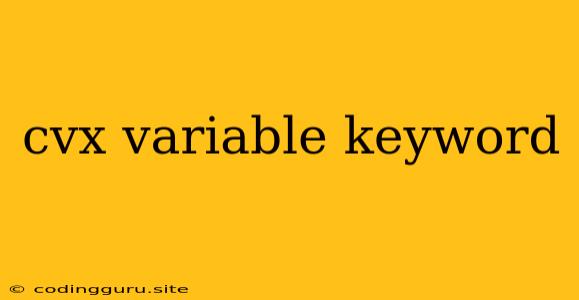Understanding CVXPY: A Powerful Tool for Convex Optimization
Convex optimization is a fundamental field in mathematics and computer science, with applications ranging from machine learning to finance. It deals with finding the best solution within a set of feasible options, where the objective function and constraints are convex. However, implementing these optimization problems can be complex and time-consuming. This is where CVXPY comes in, a powerful Python-based domain-specific language for convex optimization.
What is CVXPY?
CVXPY is a Python-embedded modeling language that makes it easy to express and solve convex optimization problems. It provides a high-level interface for formulating problems, allowing users to focus on the problem's structure rather than the underlying algorithms.
Why Use CVXPY?
- Simplicity: CVXPY's syntax closely resembles mathematical notation, making it easy to understand and translate optimization problems into code.
- Flexibility: It supports a wide range of problem types, including linear programming, quadratic programming, and semidefinite programming.
- Efficiency: CVXPY leverages efficient solvers like ECOS, SCS, and CVXOPT to solve problems quickly and reliably.
- Extensibility: You can extend CVXPY's functionality by creating custom problem classes and solvers.
Basic CVXPY Syntax
Let's illustrate the ease of using CVXPY with a simple example. Suppose we want to minimize the function x^2 + y^2 subject to the constraint x + y >= 1. In CVXPY, we would write this as:
import cvxpy as cp
# Define variables
x = cp.Variable()
y = cp.Variable()
# Define objective function
objective = cp.Minimize(x**2 + y**2)
# Define constraints
constraints = [x + y >= 1]
# Create and solve the problem
problem = cp.Problem(objective, constraints)
problem.solve()
# Print the optimal values
print("Optimal x:", x.value)
print("Optimal y:", y.value)
In this code:
- We import the
cvxpylibrary. - We define variables
xandyusingcp.Variable(). - We construct the objective function
objectiveusingcp.Minimize(). - We specify the constraint
x + y >= 1usingcp.constraintsand list comprehension. - We create the optimization problem using
cp.Problem()with the objective and constraints. - We call
problem.solve()to find the optimal solution. - Finally, we print the optimal values of
xandy.
Using CVXPY for More Complex Problems
CVXPY is capable of handling much more complex problems. Here are some scenarios where it excels:
- Portfolio Optimization: Find the optimal asset allocation to minimize risk while achieving a target return.
- Machine Learning: Train models with regularized objectives and constraints to improve performance and prevent overfitting.
- Signal Processing: Design filters and algorithms to recover signals from noisy data.
- Control Systems: Optimize the control inputs to achieve desired system performance.
- Image Processing: Solve problems related to image denoising, reconstruction, and segmentation.
Key Concepts in CVXPY
- Variables: Represent the unknowns in the optimization problem.
- Objective Function: The function to be minimized or maximized.
- Constraints: Conditions that the variables must satisfy.
- Solvers: Algorithms that find the optimal solution to the problem.
- Problem Classes: CVXPY supports several problem classes, including linear programming, quadratic programming, and semidefinite programming.
Benefits of Using CVXPY
- Faster Development: Focus on modeling the problem rather than the algorithms.
- Better Results: Leverage robust and efficient solvers for accurate and reliable solutions.
- More Readable Code: The syntax makes the code easier to understand and maintain.
- Increased Productivity: Spend less time coding and more time exploring solutions.
Conclusion
CVXPY provides a powerful and intuitive framework for solving convex optimization problems. Its user-friendly syntax and extensive capabilities make it an ideal tool for researchers, engineers, and data scientists across various domains. Whether you're working on machine learning, financial modeling, or any other field involving optimization, CVXPY can significantly simplify your workflow and help you achieve better results.
